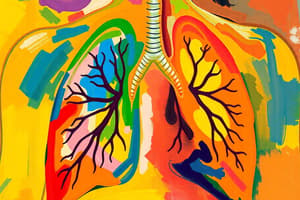Podcast
Questions and Answers
What happens to the volume of the lungs during inhalation?
What happens to the volume of the lungs during inhalation?
Where does gas exchange primarily occur in the respiratory system?
Where does gas exchange primarily occur in the respiratory system?
What is the main function of internal respiration?
What is the main function of internal respiration?
How does oxygen reach body tissues during internal respiration?
How does oxygen reach body tissues during internal respiration?
Signup and view all the answers
What happens to the muscles during exhalation?
What happens to the muscles during exhalation?
Signup and view all the answers
What is the role of hemoglobin in gas exchange?
What is the role of hemoglobin in gas exchange?
Signup and view all the answers
Which part of the respiratory system is responsible for warming, moistening, and cleaning the air before it enters the lungs?
Which part of the respiratory system is responsible for warming, moistening, and cleaning the air before it enters the lungs?
Signup and view all the answers
How many rings of cartilage reinforce the trachea in the lower respiratory system?
How many rings of cartilage reinforce the trachea in the lower respiratory system?
Signup and view all the answers
Which part of the respiratory system plays a key role in maintaining the airway's patency?
Which part of the respiratory system plays a key role in maintaining the airway's patency?
Signup and view all the answers
What is the function of the alveoli in the lower respiratory system?
What is the function of the alveoli in the lower respiratory system?
Signup and view all the answers
Which respiratory structure is part of both the digestive and respiratory systems?
Which respiratory structure is part of both the digestive and respiratory systems?
Signup and view all the answers
What process describes the inhalation and exhalation of air through the nose and mouth?
What process describes the inhalation and exhalation of air through the nose and mouth?
Signup and view all the answers
Study Notes
The Respiratory System: The Body's Gas Exchange System
The respiratory system is a vital organ system in the human body, responsible for the exchange of gases between the air and the blood, and between the blood and the body's cells. It facilitates the process of breathing, enabling the body to inhale oxygen and exhale carbon dioxide, which is a waste product. The respiratory system is divided into upper and lower parts, and it works in close conjunction with the circulatory system.
Upper Respiratory System
The upper respiratory system includes structures such as the nose, mouth, pharynx, and larynx. The nose and nasal cavity serve as the primary entry point for air, warming, moistening, and cleaning the air before it enters the lungs. The pharynx and larynx are part of the digestive system as well as the respiratory system, as they carry both food and air.
Lower Respiratory System
The lower respiratory system consists of the trachea, bronchi, bronchioles, and alveoli. The trachea, reinforced by 20 rings of cartilage, is lined with a mucous membrane and plays a key role in maintaining the airway's patency. The bronchi and bronchioles lead to the alveoli, which are tiny sacs where gas exchange occurs. There are more than 300 million alveoli in both lungs, providing a huge surface area for gas exchange.
Pulmonary Ventilation and Gas Exchange
Pulmonary ventilation is the process of breathing, where air is inhaled through the nose and mouth and exhaled out. The diaphragm and external intercostal muscles contract during inhalation, increasing the volume of the lungs and decreasing air pressure, causing air to rush in. During exhalation, the muscles relax, the lungs become smaller, air pressure rises, and air is expelled.
Gas exchange occurs at the alveoli, where oxygen from inhaled air diffuses into pulmonary capillaries surrounding them and binds to hemoglobin molecules in red blood cells. At the same time, carbon dioxide from deoxygenated blood diffuses from the capillaries into the alveoli and is expelled through exhalation.
Internal Respiration
Internal respiration is the process by which oxygen-rich blood is delivered to cells throughout the body, while carbon dioxide waste is removed. Red blood cells carry oxygen absorbed from the lungs around the body through the vasculature, then release the oxygen when it reaches the narrow capillaries. The oxygen diffuses through the capillary walls into body tissues, where it is used by cells to produce energy. Meanwhile, carbon dioxide diffuses from the tissues into red blood cells and plasma, and is carried back to the lungs for release through exhalation.
Conclusion
The respiratory system is a complex organ system that plays a crucial role in maintaining life by exchanging gases between the air and the blood and between the blood and the body's cells. Its various components work together to facilitate breathing, gas exchange, and the removal of waste products, ensuring the body's cells receive the oxygen they need to function properly.
Studying That Suits You
Use AI to generate personalized quizzes and flashcards to suit your learning preferences.
Description
Explore the anatomy and functions of the respiratory system, including the upper and lower respiratory tract, gas exchange at the alveoli, pulmonary ventilation, and internal respiration. Learn how this essential system facilitates the exchange of oxygen and carbon dioxide within the body.




